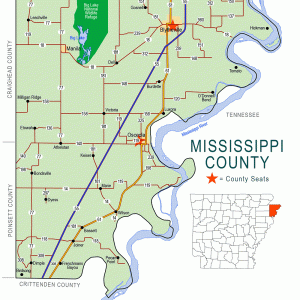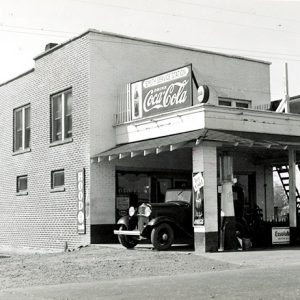calsfoundation@cals.org
Joiner (Mississippi County)
| Latitude and Longitude: | 35º30’28″N 090º08’49″W |
| Elevation: | 236 feet |
| Area: | 0.62 square miles (2020 Census) |
| Population: | 498 (2020 Census) |
| Incorporation Date: | March 20, 1922 |
Historical Population as per the U.S. Census:
|
1810 |
1820 |
1830 |
1840 |
1850 |
1860 |
1870 |
1880 |
1890 |
1900 |
|
– |
– |
– |
– |
– |
– |
– |
– |
– |
– |
|
1910 |
1920 |
1930 |
1940 |
1950 |
1960 |
1970 |
1980 |
1990 |
2000 |
|
– |
– |
306 |
388 |
596 |
748 |
839 |
725 |
645 |
540 |
|
2010 |
2020 |
|
|
|
|
|
|
|
|
|
576 |
498 |
|
|
|
|
|
|
|
|
The city of Joiner (Mississippi County) is located at the intersection of U.S. Highway 61 and State Highway 118, within an area widely recognized for its fertile farmland and its proximity to the Mississippi River and the city of Memphis, Tennessee.
There are varying accounts regarding Joiner’s beginnings. One story states that the locale was first associated with a hotel of the same name that was established by Rufus L. Joiner. This account also asserts that the spelling was originally Joyner and somehow evolved into Joiner over the years. However, Rufus L. Joiner’s biography, as published by Goodspeed’s history of the area, makes no mention of his association with a hotel, describing him only as a prominent farmer. On the other hand, Dr. D. C. Joyner had a medical practice in the same area and was purported to have “engaged in other pursuits.” In all likelihood, the two similar-sounding surnames have contributed to the confusion over the years.
Nevertheless, it is clear that the location attracted the attention of railroad executives in the early nineteenth century as they sought to expand operations in northeast Arkansas. Officials from the St. Louis–San Francisco Railway Co. (SLSF), better known as the Frisco, traveled to Mississippi County and met with the Rufus L. Joiner family. One of Joiner’s daughters, Blanche Joiner (Ware), recalled this meeting in a letter written in 1974. After an evening of dining and entertainment at the Joiner family home, the railroad administrators announced that they wished to construct a depot in the vicinity and expressed their desire to call it Joiner. Therefore, when the station was established in 1903, it was designated by that name. By 1910, Joiner began to appear in the Rand McNally Business Atlas and Shipping Guide as the southernmost depot in Mississippi County.
In 1904, Joiner was granted a post office. The first postmaster, John T. Lee, used his home as the post office until a new building could be constructed. Patrons were serviced from an open bedroom window with the sorted mail spread out on the bed. (As of 2012, Joiner’s facility is slated for closure as the U.S. Postal Service attempts to streamline its operations.)
The arrival of the railroad was a major contributor to Joiner’s prosperity. Previously, this section of Mississippi County was populated with only a smattering of farms and a few businesses. However, the transport of crops and timber was indispensable to the economic vitality of the entire region. As a result, a small community developed around the depot over the next two decades.
Joiner’s steady expansion resulted in its incorporation on March 20, 1922. The first mayor was Newt Lee, with Rufus Joiner serving as justice of the peace. Over time, a volunteer fire department, churches, schools, banks, cafes, hardware stores, grocery stores, cotton gins, a lumber yard, service stations, civic groups, and retail businesses were established to meet the needs of a growing local populace. However, just as it seemed that the town was gaining traction and poised for continued progress, a series of fires threatened its livelihood. In 1947–48, four major fires struck the town, followed by a fire that destroyed the school gymnasium in 1950. Two more fires in 1953 destroyed a grocery and nearby school. Yet it was Shawnee School (grades 1–12) that was hit the hardest. Comprising five small schools (covering the Mississippi County towns of Basset, Wardell, Joiner, Frenchman’s Bayou, and Bardstown) that were consolidated in 1925, Shawnee School suffered four devastating fires in the 1940s that destroyed a major portion of the school. Although the school was rebuilt and served the community for the next twenty years, it eventually was further consolidated within the county during the 1970s. As of 2012, the remaining elementary school grades are also slated for consolidation at another location within the county.
As the importance of railroads began to diminish, Joiner’s economic vitality began to decline as well. With changes in farming and demographic shifts, the community began to shrink, leaving the town with deserted buildings and vacant lots. The Frisco train depot that launched Joiner’s economy and served the community over several decades was eventually abandoned and demolished.
Joiner was the birthplace of Alvin S. Bennett (1926–1989), a record company executive for whom the character Alvin of Alvin and the Chipmunks was named.
For additional information:
Baker, William D. Historic Railroad Depots of Arkansas, 1870–1940. Little Rock: Arkansas Historic Preservation Program, 1991.
Biographical and Historical Memoirs of Northeast Arkansas. Chicago: Goodspeed Publishing Co., 1890.
Brown, Edna. “2nd Class City and Proud of It.” Blytheville Courier News, December 5, 1953, p. 3.
“Downtown Joiner Hit Again By Big Blaze As Fire Jinx Continues.” Blytheville Courier News, June 22, 1954, p. 1.
“Joiner Firemen Beat off Threat of Fire Disaster.” Blytheville Courier News, December 6, 1949, p. 1.
“Joiner Founded on Site of Hotel Erected a Century Ago.” Blytheville Courier News, October 10, 1950, p. 11E.
Otto, John Solomon. The Final Frontiers, 1880–1930: Settling the Southern Bottomlands. Westport, CT: Greenwood Publishing, 1999.
Townsend, Guy. “Consolidation Bullet Found Tough to Bite.” Blytheville Courier News, May 9, 1979, p. 16.
Whayne, Jeannie. Delta Empire: Lee Wilson and the Transformation of Agriculture in the New South. Baton Rouge: Louisiana State University Press, 2011.
Toney Butler Schlesinger
Granite Bay, California
 Joiner City Hall
Joiner City Hall  Joiner
Joiner  Mississippi County Map
Mississippi County Map  V. R. Smith Filling Station
V. R. Smith Filling Station 




Have wonderful memories of Joiner. Started school grades 1-5. My family lived on Richard Ackles’s farm. My father Amos Goodman worked for Ekwin (not a right spelling). He owned the John Deere where he was mechanic. He was very great man for Daddy. We moved to West Memphis in 1960.
I loved the Shawnee school and 10 cent movie house, and Mr. Ackles’s grocery store across train tracks. Tootsie fruity ice cream at the small ice cream and hamburger shack and roasted peanuts at the small produce store on the front porch of their house. Ice house and coal yard beside. All my brothers worked for the Goodman family, working in the cotton field, except Daddy. Post office on Highway 61. Also had bus station. Ice barn. Parts store, and many other shops, even a dollar store then called 5 and Dime. Also a department store where Easter wear and school clothes could be put on layaway. Baptist church and Dr. Sanders’s office, later Dr. Lupin; he moved to Turell where all my sisters and brothers had their babies. And my surprise sister was born in 1961.
I have so much more. But Joiner was a great place. My daddy is in the Baptist cemetery along with more we will remember.
Thank you for letting me go back in time. Maybe it’s gone thanks to the interstate. But it had spots that never change.